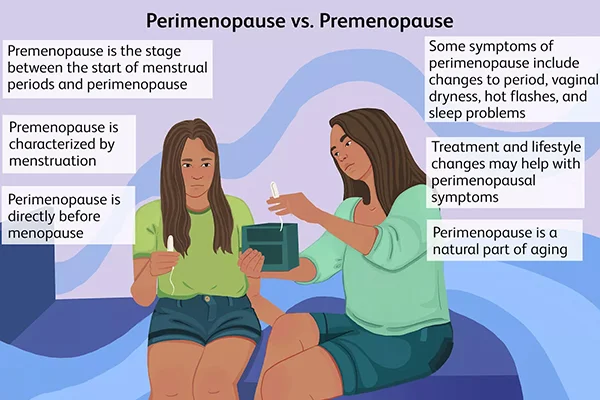As women, understanding the various phases of our reproductive lives is crucial for maintaining our overall well-being. But, do you really know the difference between premenopause vs perimenopause? These two stages can have a significant impact on our bodies and minds. Let’s dive into the details and discover how to navigate these crucial phases to ensure a smooth transition and improved health.
Key Takeaways
- Premenopause and perimenopause are stages of hormonal changes that can cause a variety of symptoms.
- Estrogen and progesterone levels decline during perimenopause, leading to physical & emotional changes.
- Managing & treating these symptoms can be done with lifestyle changes, hormone therapy or alternative treatments, consult your healthcare provider for the best plan!
Understanding Premenopause and Perimenopause

Premenopause and perimenopause are often confused terms, but they represent distinct stages of a woman’s reproductive life. Recognizing the difference between perimenopause and premenopause is vital for effective health management and early detection of menopause signs.
Premenopause refers to the time between when a woman starts getting her menstrual period and when menopause begins. On the other hand, perimenopause is the period leading up to menopause, characterized by the beginning menopause symptoms. Most American women reach menopause between the ages of 40 and 58, with the average age being 51.
Premenopause
During premenopause, women are still in their reproductive years without any signs or symptoms of menopause or perimenopause. This phase usually starts when women reach their mid to late 40s, a time when some might begin exploring prescription treatments for perimenopause.
As hormonal changes start to occur during premenopause, women may experience symptoms such as hot flashes and night sweats. These changes, particularly in estrogen levels, can cause irregular menstrual cycles and other discomforts.
Perimenopause and Menopause
The perimenopause stage, on the other hand, is the transitional phase leading up to menopause. This stage is characterized by hormonal changes and various symptoms, such as:
- irregular periods
- hot flashes
- vaginal dryness
- mood changes
Perimenopause can last anywhere from a few months to 10 years, with the end marked by 12 months without a period. During this stage, the ovaries start producing less estrogen in preparation for halting egg release, a process that triggers the common symptoms associated with perimenopause.
Hormonal Changes in Premenopause and Perimenopause

Fluctuations in estrogen and progesterone levels are common during both premenopause and perimenopause. These hormonal changes can lead to a variety of classic menopause symptoms, including:
- Irregular menstrual cycles
- Hot flashes
- Night sweats
- Mood swings
- Fatigue
- Insomnia
- Vaginal dryness
- Decreased libido
- Weight gain
- Memory problems
If you are experiencing any of these symptoms, it is important to consult with your healthcare provider for proper diagnosis and treatment options.
Comprehending these hormonal shifts is vital for managing symptoms and navigating transitions from premenopause to perimenopause and menopause. Seeking timely medical care and support during these phases is also important for maintaining optimal health and well-being.
Estrogen Levels
In perimenopause, the body’s estrogen levels begin to decline, creating an imbalance with progesterone. This drop can trigger a range of discomforting symptoms, including:
- Hot flashes
- Night sweats
- Irregular menstruation
- Reduced libido
- Decreased bone density
- Headaches
- Mood fluctuations
- Dry skin
Progesterone Levels
Progesterone levels also fluctuate during perimenopause, affecting ovulation and menstruation. These fluctuations can cause hot flashes, night sweats, mood swings, and irregular periods.
The imbalance between progesterone and estrogen can contribute to the overall hormonal changes experienced during this transitional phase.
Common Symptoms of Perimenopause

Perimenopause can bring a range of symptoms that impact a woman’s daily life. Some of the most common symptoms include:
These symptoms, including menstrual bleeding, can vary in intensity and frequency throughout the menstrual cycle, underscoring the importance for women to be mindful of the ongoing changes in their bodies, especially when dealing with frequent urinary tract infections.
Women may experience the following symptoms as their first sign of perimenopause:
- Irregular periods
- Hot flashes
- Night sweats
- Mood swings
- Headaches
- Changes in sex drive
These symptoms are common and typically signal the beginning of the transition to menopause. As estrogen levels fluctuate, they can disrupt sleep and affect daily activities.
Early Menopause and Early Perimenopause

Premature menopause occurs when menopause happens in women under 40 years old. This early onset can be due to certain medical conditions, procedures, or primary ovarian insufficiency when there is no medical or surgical cause. Genetic factors can also play a role in premature menopause, with a family history of early menopause increasing the likelihood of experiencing it.
The symptoms of premature menopause and early perimenopause are similar to those of natural menopause but may be more intense. Women experiencing premature menopause or early perimenopause face increased health risks, such as osteoporosis, heart disease, and cognitive decline.
Managing and Treating Symptoms

Perimenopause symptoms can be managed and treated through lifestyle modifications, hormone therapy, and alternative treatments. By integrating these strategies, women can alleviate discomfort from perimenopause symptoms and enhance their overall quality of life.
Seeking timely medical care and support during perimenopause is necessary for effective symptom management. Collaborating with a healthcare professional can guide you in determining the most beneficial strategies for your unique needs and health objectives.
Lifestyle Changes
Regular exercise, relaxation techniques, and avoiding daytime naps can help alleviate perimenopause symptoms. Some recommended activities include:
- Engaging in aerobic exercises
- Strength training
- Flexibility exercises
- Balance exercises
These activities can promote overall health and well-being during this transitional phase.
Relaxation techniques, such as:
- deep breathing
- meditation
- progressive muscle relaxation
- paced respiration
You can also help manage perimenopause symptoms by reducing stress and the severity of hot flashes. Maintaining a consistent sleep schedule and avoiding napping in the late afternoon or evening can further improve nighttime sleep quality.
Hormone Therapy
Hormone therapy, including estrogen therapy, can help normalize hormone levels and reduce symptoms. Estrogen therapy, usually combined with progestin, is available in various forms and can help balance estrogen levels, ease symptoms, and potentially lower the risk of osteoporosis.
While hormone therapy offers an effective solution for many women, consulting with a healthcare professional to determine the most suitable treatment approach is crucial. This ensures the therapy aligns with your specific needs and health objectives.
Alternative Treatments
For some women, alternative treatments such as herbal supplements and acupuncture may provide relief from perimenopause symptoms. Popular herbs used in supplements include:
These herbs can help reduce hot flashes, night sweats, mood swings, and other perimenopausal symptoms.
While some women may find relief in alternative treatments, it’s worth noting that these supplements’ effectiveness in treating perimenopause is not conclusively proven. Consultation with a healthcare professional before embarking on any alternative treatments or considering prescription perimenopause treatment is always recommended to ensure their safety and suitability to your needs.
Fertility and Conception During Perimenopause

Fertility and conception during perimenopause can be challenging due to irregular ovulation and declining fertility. While fertility decreases during perimenopause, it is still possible to get pregnant.
Navigating fertility during perimenopause requires understanding one’s body, tracking menstrual cycles, and working closely with healthcare professionals. Being aware of the changes taking place during this phase and seeking appropriate medical care can help improve the chances of successful conception.
Navigating the Menopause Transition

Successful transition through menopause involves understanding the differences among premenopause, perimenopause, and menopause, coupled with appropriate medical care and support. Early recognition of menopause and perimenopause signs can aid women in managing their health better and making more informed decisions about their reproductive choices.
The average age for menopause in the US is 51, but it can vary depending on race and ethnicity. By staying informed and working closely with healthcare professionals, women can navigate the menopause transition with confidence and grace.
Summary
In conclusion, understanding the differences between premenopause, perimenopause, and menopause is essential for managing one’s reproductive health effectively. By recognizing the early signs of menopause, adopting lifestyle changes, exploring treatment options, and working closely with healthcare professionals, women can successfully navigate the menopause transition and maintain their overall well-being.
Frequently Asked Questions
What’s the difference between premenopause and perimenopause?
Perimenopause and premenopause differ in that perimenopause is often used to describe the years before menopause, while premenopause more accurately means the time directly before menopause.
What is the typical age for perimenopause?
Perimenopause typically starts in women ages 40 to 44 and can be marked by changes in menstrual flow, cycle length and surges in estrogen.
What are 3 symptoms of perimenopause other than hot flashes?
Perimenopause is often characterized by hot flashes, night sweats, and vaginal dryness. Other common symptoms may include mood changes, changes in sexual desire, difficulty concentrating, headaches, trouble sleeping, and leaking pee when sneezing or coughing.
How do you know if you are premenopausal?
If you experience persistent changes in your menstrual cycle, hot flashes or sleep problems, you may be in the early to late stages of premenopause. Symptoms like these should be discussed with a doctor for proper diagnosis and treatment.
How long does perimenopause typically last?
Perimenopause typically lasts a few months up to 10 years, ending after 12 months without a period.
About PatchMD
PatchMD topical vitamin patches offer a solution for those looking to work through nutrient deficiencies and finding a creative way to take their vitamin supplements. Whether you have had a bariatric surgery an issue with absorbing pills or just issues with compliance, our top products like multivitamin patches, kids multivitamin, hangover plus (now Happy Hour), B12 Energy plus, Vitamin D3, the C Plus vitamin patch, our new L-lysine/Zinc Plus patch and so many more! Free Shipping over $59. Learn More about PatchMD’s Menopause Day Relief Patch and PatchMD’s Menopause Night Relief Patch.









Leave A Comment
You must be logged in to post a comment.